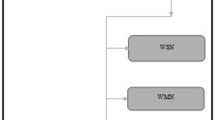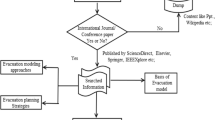Abstract
Mobile ad hoc networks (MANETs) are defined as a collection of wireless mobile nodes that are characterized as independent, dynamic, self-adaptive and infrastructure less. This mobility and dynamic in nature of MANET urge for new set of networking strategies to be implemented so as to provide efficient communication during natural disaster. Mobile crowd management is yet an emerging new exploration for search and rescue (SAR) operations. The phase of catastrophic management has communication to play a vital role. In MANETs, the end nodes communicate through the TCP/IP protocol. The layers of TCP/IP model change frequently due to mobility and resource overhead. This makes routing in MANETs one of the challenging research area. This review provides an overview of MANET based routing protocols employed for communication during SAR operations. The main purpose of this survey is to provide taxonomy on communication strategies of MANETs during disaster and emergency situation. Furthermore, this paper examines the existing MANET based SAR techniques and the significant contribution made by researches in the past few years based upon routing protocol, communication techniques, type of infrastructure and phase of disaster management.









Similar content being viewed by others
References
Sharma, R. (2012). Mobile ad hoc networks—A holistic overview, 52(21), 31–36.
Jiazi, Y. I. (2008). A survey on the applications of MANET. Polytech’Nantes, February (pp. 721–726).
Fujiwara, T., & Watanabe, T. (2005). An ad hoc networking scheme in hybrid networks for emergency communications. Ad Hoc Networks, 3(5), 607–620. doi:10.1016/j.adhoc.2004.08.007.
Murthy, S., & Gracia, J. J. (1996). An efficient routing protocol for Wireless Networks. ACM Journal of Mobile Networks and Applications, 1(2), 183–197.
Hamza, A., Tariq, A., Helge, J., & Ali Al-Bayatti. (2012). Data confidentiality in mobile Ad hoc networks. International Journal of Wireless & Mobile Networks (IJWMN), 4(1). doi:10.5121/ijwmn.2012.4117.
Royer, E. M., & Toh, C. (1999). A review of current routing protocols for ad-hoc mobile wireless networks. IEEE Personal Communications Magazine, 6(2), 46–55.
Onwuka, E., Folaponmile, A., & Ahmed, M. (2011). Manet: A reliable network in disaster areas. Jorind, 9(2), 105–113.
Tarique, M., Tepe, K. E., Adibi, S., & Erfani, S. (2009). Survey of multipath routing protocols for mobile ad hoc networks. Journal of Network and Computer Applications, 32(6), 1125–1143. doi:10.1016/j.jnca.2009.07.002.
Smith, P., & Simpson, D. (2009). Technology and communications in an urban crisis: The role of mobile communications systems in disasters. Journal of Urban Technology, 16(1), 133–149. doi:10.1080/10630730903076494.
Monares, Á., Ochoa, S. F., Pino, J. A., Herskovic, V., Rodriguez-Covili, J., & Neyem, A. (2011). Mobile computing in urban emergency situations: Improving the support to firefighters in the field. Expert Systems with Applications, 38, 1255–1267. doi:10.1016/j.eswa.2010.05.018.
Lenert, L., Chan, T. C., Griswold, W., Killeen, J., Palmer, D., Kirsh, D., Mishra, R., & Rao, R. (2005). Wireless internet information system for medical response in disasters (WIISARD). In: AMIA annual symposium proceedings(pp. 429–433).
Shnayder, V., Chen, B., Lorincz, K., Fulford-Jones, T. R. F., & Welsh, M. (2005). Sensor networks for medical care. Proceedings of the 3rd International Conference on Embedded Networked Sensor Systems. San Diego, California. doi:10.1145/1098918.1098979.
Velasco, J. R., López-Carmona, M. A., & Sedano, M. (2006). Role of multi-agent system on minimalist infrastructure for service provisioning in Ad-Hoc networks for emergencies. Proceedings of First International Workshop on Agent Technology for Disaster Management, AAMAS'06 (pp. 151–152). Hakodate, Japan.
Fry, E. A., & Lenert, L. A. (2005). MASCAL: RFID tracking of patients, staff and equipment to enhance hospital response to mass casualty events. Proceedings of AMIA Annual Symposium (pp. 261–265).
Martí, R., Robles, S., Martín-Campillo, A., & Cucurull, J. (2009). Providing early resource allocation during emergencies: The mobile triage tag. Journal of Network and Computer Applications, 32, 1167–1182. doi:10.1016/j.jnca.2009.05.006.
Robinson, W. H., & Lauf, A. P. (2013). Resilient and efficient MANET aerial communications for search and rescue applications. In 2013 international conference on computing, networking and communications, ICNC 2013 (pp. 845–849). doi:10.1109/ICCNC.2013.6504199.
Raffelsberger, C., & Hellwagner, H. (2013). A hybrid MANET–DTN routing scheme for emergency response scenarios. In 2013 IEEE international conference on pervasive computing and communications workshops (PERCOM Workshops) (pp. 505–510). doi:10.1109/PerComW.2013.6529549.
Van Westen, C. (2000). Remote sensing for natural disaster management. Archives of Photogrammetry and Remote Sensing, 33, 1609–1617.
Shesh Kumar, S., Ramendra, K., Anshul, G., & Kamaljeet, P. (2014). Routing protocols and security issues in MANET: A survey. International Journal of Emerging Technology and Advanced Engineering. (IJETAE), 4(4).
Fajardo, J. T. B., & Oppus, C. M. (2010). A mobile disaster management system using the Android technology. WSEAS Transactions on Communications, 9(6), 343–353.
Abolhasan, M., Wysocki, T., & Dutkiewicz, E. (2003). A review of routing protocols for mobile ad hoc networks. Ad Hoc Networks, 2, 1–22. doi:10.1016/S1570-8705(03)00043-X.
Mueller, S., Tsang, R. P., & Ghosal, D. (2004). Multipath routing in mobile ad hoc networks: Issues and challenges. In: M. C. Calzarossa & E. Gelenbe (Eds.), MASCOTS. LNCS (Vol. 2965, pp. 209–234). Heidelberg: Springer.
Baseer, S., Channa, M. I., & Ahmed, K. (2010). A review of routing protocols of heterogeneous networks. IJCA Special Issue on Mobile Adhoc Networks MANETs (2), 58–66. doi:10.5120/1021-63.
Kwan, M.-P., & Lee, J. (2005). Emergency response after 9/11: The potential of real-time 3D GIS for quick emergency response in micro-spatial environments. Computers, Environment and Urban Systems, 29(2), 93–113. doi:10.1016/j.compenvurbsys.2003.08.002.
Sasaki, Y., & Shibata, Y. (2010). Distributed disaster information system in DTN based mobile communication environment. In Proceedings—2010 international conference on broadband, wireless computing communication and applications, BWCCA 2010 (pp. 274–277). doi:10.1109/BWCCA.2010.81.
Sanderson, N., Goebel, V., & Munthe-Kaas, E. (2005). Metadata management for ad-hoc infoware—A rescue and emergency use case for mobile ad-hoc scenarios. In On the move to meaningful internet systems 2005: CoopIS, DOA, and ODBASE—OTM confederated international conferences, CoopIS, DOA, and ODBASE 2005, Proceedings, Part II, Agia Napa, Cyprus (Vol. 3761, No. 152929, pp. 1365–1380). doi:10.1007/11575801_27.
Shao, Z., Liu, Y., Wu, Y., & Shen, L. (2011). A rapid and reliable disaster emergency mobile communication system via aerial Ad Hoc BS networks. In 7th international conference on wireless communications, networking and mobile computing, WiCOM 2011, (2007) (pp. 8–11). doi:10.1109/wicom.2011.6040479.
Tsai, C.-S., & He, C.-Y. (2010). A Novel Group communication for disaster positioning in mobile ad hoc network. In 2010 IEEE RIVF international conference on computing and communication technologies, research, innovation, and vision for the future (RIVF) (pp. 1–4). doi:10.1109/RIVF.2010.5633127.
Grilo, A., Macedo, M., Sebastião, P., & Nunes, M. (2007). Electronic protection and routing optimization of MANETs operating in an electronic warfare environment. Ad Hoc Networks, 5(7), 1031–1045. doi:10.1016/j.adhoc.2006.05.002.
Martín-Campillo, A., Crowcroft, J., Yoneki, E., & Martí, R. (2013). Evaluating opportunistic networks in disaster scenarios. Journal of Network and Computer Applications, 36(2), 870–880. doi:10.1016/j.jnca.2012.11.001.
Niranjan, D., & Vatsa, A. K. (2011). Context based location management for MANET in disaster area using mobile agent, 8491, 277–282.
Szczodrak, M., & Kim, J. (2007). 4G and MANET, Wireless network of future battlefield. Proceedings of the 2007 International Conference on Security and Management (pp. 282–288). Las Vegas: USA.
Lien, Y., Jang, H., & Tsai, T. (2010). P2Pnet : A MANET based emergency communication system for catastrophic natural disasters. Communications. doi:10.1109/ICDCSW.2009.72.
Mccarthy, B., Edwards, C., & Dunmore, M. (2006). The integration of ad hoc (MANET) and mobile networking (NEMO): Principles to support rescue team communication. In Icmu (pp. 284–289).
MacOne, D., Oddi, G., & Pietrabissa, A. (2013). MQ-routing: Mobility-, GPS- and energy-aware routing protocol in MANETs for disaster relief scenarios. Ad Hoc Networks, 11(3), 861–878. doi:10.1016/j.adhoc.2012.09.008.
Mahapatra, R. P., Abbasi, T. A., & Abbasi, M. S. (2010). A propose architecture of MANET for disaster area architecture. International Journal of Computer Theory and Engineering, 2(1), 31–34. doi:10.7763/IJCTE.2010.V2.112.
Lu, W., Sean, W. K. G., Pen, E. W. C., & Ge, Y. (2007). Communications support for disaster recovery operations using hybrid mobile ad-hoc networks. In 32nd IEEE conference on local computer networks, 2007. LCN 2007 (pp. 763–770). doi:10.1109/LCN.2007.97.
Robinson, W. H., & Lauf, A. P. (2013). Aerial MANETs: Developing a resilient and efficient platform for search and rescue applications. Journal of Communications, 8(4), 216–224. doi:10.12720/jcm.8.4.216-224.
Chen, L., Loschonsky, M., & Reindl, L. M. (2010). Large-scale fading model for mobile communications in disaster and salvage scenarios. In IEEE international conference on wireless communications and signal processing (WCSP 2010), Suzhou, China.
Aldunate, R., Ochoa, S. F., Peña-Mora, F., & Nussbaum, M. (2006). Robust mobile ad hoc space for collaboration to support disaster relief efforts involving critical physical infrastructure. Journal of Computing in Civil Engineering, 20(1), 13. doi:10.1061/(ASCE)0887-3801(2006)20:1(13).
Fujino, Y., Miura, A., Hamamoto, N., Tsuji, H., & Suziki, R. (2011). Satellite terrestrial integrated mobile communication system as a disaster countermeasure. In General assembly and scientific symposium, 2011 XXXth URSI.
Munro, R. (2012). Crowdsourcing and the crisis-affected community. Information retrieval (Vol. 16). doi:10.1007/s10791-012-9203-2.
Schöning, J., Rohs, M., Krüger, A., & Stasch, C. (2009). Improving the communication of spatial information in crisis response by combining paper maps and mobile devices. In Mobile response: Second international workshop on mobile information technology for emergency response (pp. 57–65). doi:10.1007/978-3-642-00440-7_6.
Singh, G., Prof, A., & Singh, J. (2012). MANET: Issues and behavior analysis of routing protocols. International Journal of Advanced Research in Computer Science and Software Engineering, 2(4), 219–227.
Islam, N., & Shaikh, Z. A. (2013). Book chapter on security issues in mobile ad hoc networks. In S. Khan & A.-S. K. Pathan (Eds.), Wireless Networks and Security: Issues, Challenges and Research Trends (pp. 49–56). Heidelberg: Springer.
Sharma, S. K., Kumar, R., Gangwar, A., & Pakhre, K. (2014). Routing protocols and security issues in MANET: A survey. International Journal of Emerging Technology and Advanced Engineering, (IJETAE), 4(4), 918–924.
Djenouri, D., & Khelladi, L. (2005). A survey of security issues in mobile ad hoc networks. IEEE Communications Surveys, 11(02), 129–137.
Cervera, G., Barbeau, M., Garcia-alfaro, J. (2014). Security issues in link state routing protocols for MANETs. In: E. Kranakis (Ed.), Advances in Network Analysis and its Applications (Vol. 18, pp. 117–148). Heidelberg: Springer.
Aftab, A., & Aftab, A. (2014). Possible solutions of different security issues and challenges in mobile ad-hoc networks (MANETs). International Journal of Multidisciplinary Sciences and Engineering, (IJMSE), 5(6), 19–23.
Al Amri, H. (2012). Enhancing the scalability of heterogeneous MANET routing protocols. Ph.D. Thesis School of Electrical, Computer and Telecommunications Engineering, University Wollongon, 2012.
Baccelli, E., Schiller, J., & Universit, F. (2008). Towards scalable MANETs. In 8th IEEE international conference on ITS telecommunications (No. 10, pp. 133–138). doi:10.1109/ITST.2008.4740243.
Lee, B., Yu, C., & Moh, S. (2005). Issues in scalable clustered network architecture for mobile ad hoc networks. Handbook of Mobile Computing (pp. 611—637). Boca Raton: CRC Press.
Fernando, N., Loke, S. W., & Rahayu, W. (2013). Mobile cloud computing: A survey. Future generation computer systems, 29(1), 84–106. doi:10.1016/j.future.2012.05.023.
Sukanya, C. M., Priya, K. V., Paul, Vince, & Sankaranarayanan, P. N. (2014). Integration of wireless sensor networks and cloud computing. International Journal of Computer Science, C, 2(5), 49–53.
Author information
Authors and Affiliations
Corresponding author
Rights and permissions
About this article
Cite this article
Anjum, S.S., Noor, R.M. & Anisi, M.H. Review on MANET Based Communication for Search and Rescue Operations. Wireless Pers Commun 94, 31–52 (2017). https://doi.org/10.1007/s11277-015-3155-y
Published:
Issue Date:
DOI: https://doi.org/10.1007/s11277-015-3155-y




